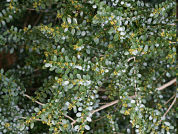Factors modeling the leaf miner pattern in the shrub Azara microphylla
DOI:
https://doi.org/10.25260/EA.16.25.3.0.166Abstract
The activity of herbivores may depend on resource characteristics as well as on interactions with other organisms that consume leaves. We analyzed the effect of leaf toughness and the probability of leaf damage on the activity and efficiency of leaf miners in the shrub Azara microphylla. Basal sectors of the leaves showed higher toughness and lower probability of damage by other herbivores, fungus and pathogens than apical leaf sectors. Leaf-miner activity was concentrated in basal leaf sectors, although they mainly initiated their activity in apical sectors (their preferred place to oviposit). Leaf-miner efficiency was similar in both leaf sectors. These results suggest that the interaction with other organisms that attack leaves play a relevant role modeling the foraging activity of leaf miners, illustrating how the construction that organisms build (i.e., trail miners) can be used to study their ecology and behavior.
References
BAIRSTOW, K; K CLARKE; M MCGEOCH & N ANDREW. 2010. Leaf miner and plant galler species richness on Acacia: relative importance of plant traits and climate Oecologia, 163:437-448.
BÖHM, SM; K WELLS & EKV KALKO. 2011. Top-Down Control of Herbivory by Birds and Bats in the Canopy of Temperate Broad-Leaved Oaks (Quercus robur). PLOS ONE, 6:e17857. doi:10.1371/journal.pone.0017857.
BULTMAN, T & S FAETH. 1986. Effect of within-leaf density and leaf size on pupal weight of a leaf-miner, cameraria (lepidoptera: gracillariidae). The Southwestern Naturalist, 31:201-206.
CHOONG, MF. 1996. What makes a leaf tough and how this affects the pattern of Castanopsis fissa leaf consumption by caterpillars. Functional Ecology, 10:668-674.
COLEY, PD & JA BARONE. 1996. Herbivory and plant defenses in tropical forests. Annual Review of Ecology and Systematics, 27:305-335.
CORNELISSEN, T & P STILING. 2008. Clumped distribution of oak leaf miners between and within plants. Basic and Applied Ecology, 9:67-77.
CUAUTLE, M & V RICO-GRAY. 2003. The effect of wasps and ants on the reproductive success of the extrafloral nectaried plant Turnera ulmifolia (Turneraceae). Functional Ecology, 17:417-423.
DENNO, RF; MS MCCLURE & JR OTT. 1995. Interspecific interactions in phytophagous insects: competition re-examined and resurrected. Annual Review of Entomology, 40:297- 331.
DIRZO, R & C DOMÍNGUEZ. 1995. Plant-herbivore interactions in Mesoamerican tropical dry forests. Pp. 304-345 in: Bullock, S; S Mooney & E Medina (eds.). Seasonally dry tropical forests. Cambridge University, Massachusetts.
DOMÍNGUEZ, CA; R DIRZO & SH BULLOCK. 1989. On the function of floral nectar in Croton suberosus (Euphorbiaceae). Oikos, 56:109-114.
FISHER; A; SE HARTLEY & M YOUNG. 1999. Behavioural responses of the leaf-chewing guild to the presence of Eriocrania mines on silver birch (Betula pendula). Ecological Entomology, 24:15-162
FISHER; A; SE HARTLEY & M YOUNG. 2000. Direct and indirect competitive efects of foliage feeding guilds on the performance of the birch leaf-miner Eriocrania. Journal of Animal Ecology, 69:165-176.
HOWARD, JJ. 1987. Leaf-cutting and Diet Selection: Relative Influence of Leaf Chemistry and Physical Features. Ecology, 69:250-260.
KAPLAN, I & RF DENNO. 2007. Interspecific interactions in phytophagous insects revisited: a quantitative assessment of competition theory. Ecology Letters, 10:977-994.
KARBAN, R. 1986 Interspecific competition between folivorous insects on Erigeron glaucus. Ecology, 67:1063-072.
LUCAS, PW; IM TURNER; NJ DOMINY & N YAMASHITA. 2000. Mechanical defenses to herbivory. Ann. Bot., 86:913-920.
MARQUIS, RJ & CJ WHELAN. 1994. Insectivorous birds increase growth of white oak through consumption of leaf-chewing insects. Ecology, 75:2007-2014.
MCARTHUR, C; P BANKS; P BOONSTRA; R JENNIF & J FORBEY. 2014. The dilemma of foraging herbivores: dealing with food and fear. Oecologia, 176:677-689.
RZANNY, M; A KUU & W VOIGT. 2012. Bottom-up and top-down forces structuring consumer communities in an experimental grassland. Oikos, 122:967-976.
SINCLAIR, R & L HUGHERS. 2012. Leaf miners: The hidden herbivores. Austral Ecology, 35:300-313.
TEAFORD, MF; PW LUCAS; PS UNGAR & KE GLANDER. 2006. Mechanical Defenses in Leaves Eaten by Costa Rican Howling Monkeys (Alouatta palliata). American Journal of Physical Anthropology, 129:99-104.
THOMPSON, J. 1998. Evolutionary ecology of the relationship between oviposition reference and performance of offspring in phytophagous insects. Entomologia Experimentalis et Applicata, 47:3-14.
TURNER, JS. 2000. The Extended Organism: The Physiology of Animal-Built Structures. Harvard University Press, Cambridge, Massachusetts.
YAMAZAKI, K & S SUGIURA. 2008. Deer predation on leaf miners via leaf abscission. Naturwissenschaften, 95:263-268.
ZAR, JH. 1999. Biostatistical Analysis. Prentice-Hall. London. Pp. 717.

Downloads
Additional Files
Published
How to Cite
Issue
Section
License
Copyright (c) 2016 Laila D. Kazimierski, Alejandro Farji-Brener

This work is licensed under a Creative Commons Attribution 3.0 Unported License.
Authors retain their rights as follows: 1) by granting the journal the right to its first publication, and 2) by registering the published article with a Creative Commons Attribution License (CC-BY 4.0), which allows authors and third parties to view and use it as long as they clearly mention its origin (citation or reference, including authorship and first publication in this journal). Authors can make other non-exclusive distribution agreements as long as they clearly indicate their origin and are encouraged to widely share and disseminate the published version of their work.


